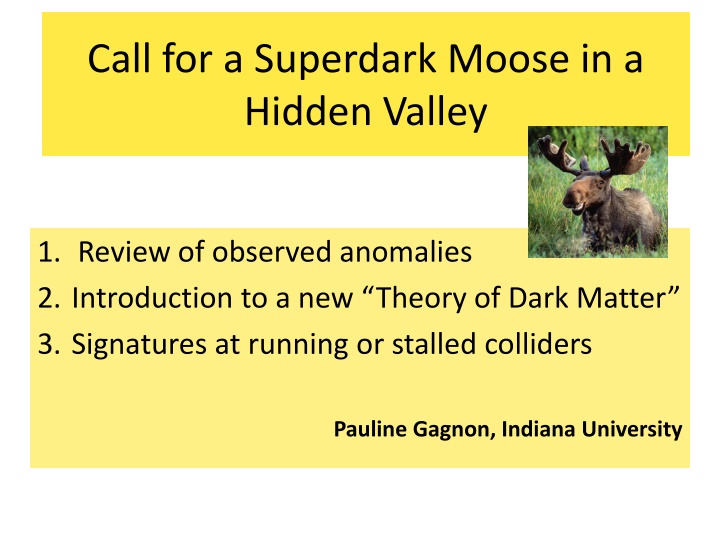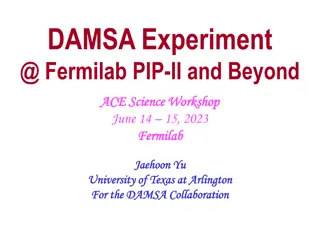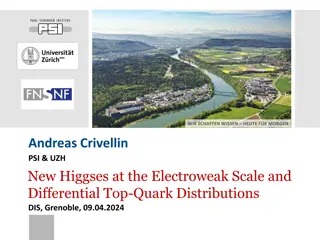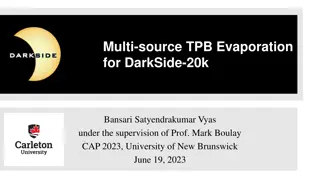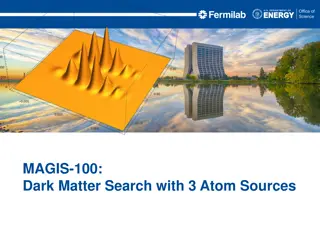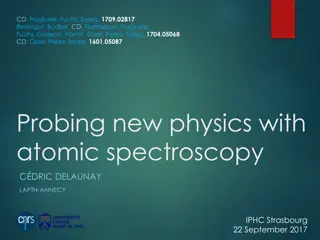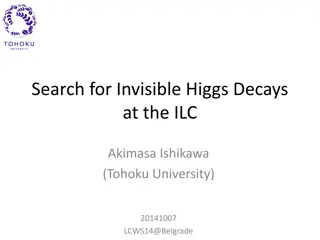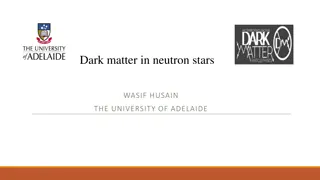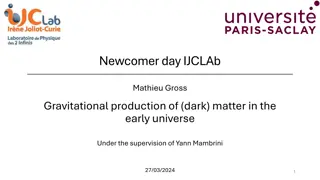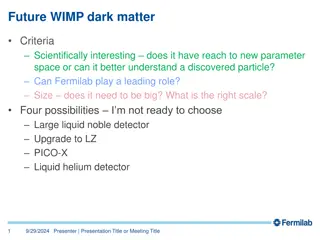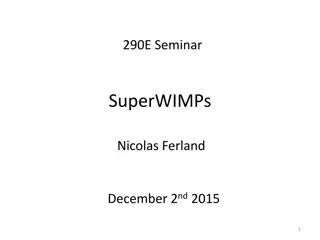Unveiling Dark Matter: An Exploration Beyond the Standard Model
Delve into the intriguing realm of dark matter through observed anomalies, a new theory introduction, and collider signatures. Uncover evidence of dark matter's existence through phenomena such as the bullet cluster, weak gravitational lensing, and unexplained astrophysics anomalies. Join the quest to understand this enigmatic substance that challenges the boundaries of the Standard Model.
Download Presentation

Please find below an Image/Link to download the presentation.
The content on the website is provided AS IS for your information and personal use only. It may not be sold, licensed, or shared on other websites without obtaining consent from the author.If you encounter any issues during the download, it is possible that the publisher has removed the file from their server.
You are allowed to download the files provided on this website for personal or commercial use, subject to the condition that they are used lawfully. All files are the property of their respective owners.
The content on the website is provided AS IS for your information and personal use only. It may not be sold, licensed, or shared on other websites without obtaining consent from the author.
E N D
Presentation Transcript
Call for a Superdark Moose in a Hidden Valley 1. Review of observed anomalies 2. Introduction to a new Theory of Dark Matter 3. Signatures at running or stalled colliders Pauline Gagnon, Indiana University
Is there something beyond the Standard Model ? Yes, and dark matter is the best proof! Slide from John Ellis 8/22/2024 Pauline Gagnon, Indiana University 2
Proof that dark matter exists: the bullet cluster Picture of two galaxy clusters hitting each other What collides is the inter-galactic material (gas) It heats up to 160x106 oC then emits X-rays What we see here is the intensity of X-rays emission Exposition time: 140 hours! Picture is 1.6 light-year wide 8/22/2024 Pauline Gagnon, Indiana University 3
Dark Matter is seen by Weak Gravitational Lensing Same event seen by the Hubble telescope through gravitational lensing Dark matter from each cluster passed over each other without interacting Shows the contours of gravitational field caused by dark matter 8/22/2024 Pauline Gagnon, Indiana University 4
So dark matter is there but interacts very weakly Inter-galactic gas clouds collided but the dark matter kept moving on Center of gravity for visible matter and dark matter different 8/22/2024 Pauline Gagnon, Indiana University 5
What is this dark matter? Could it explain many observed astrophysics anomalies? 8/22/2024 Pauline Gagnon, Indiana University 6
Six observed, unexplained anomalies from astrophysics High energy anomalies 1. PAMELA/HEAT 2. ATIC 3. WMAP haze 4. EGRET Low energy anomalies 1. INTEGRAL 2. DAMA/LIBRA 8/22/2024 Pauline Gagnon, Indiana University 7
1. The PAMELA/HEAT anomaly: (PAMELA: Payload for Antimatter Exploration and Light-nuclei Astrophysics) - observed positron flux from cosmic rays e+ / ( e+ + e-) larger than expected; -first seen by HEAT; confirmed by PAMELA - no such excess seen for protons - could come from high energy cosmic ray interactions with interstellar medium; or could be due to nearby mature pulsars 8/22/2024 Pauline Gagnon, Indiana University 8
Pulsar or Dark Matter? Fermi may tell Flux from pulsar characterized by steps DM would give a power law spectrum Malyshev, Cholis & Gelfand suggest Fermi could resolve this with one year of data (arXiv:0903.1310 ) ATNF: catalog of all known pulsars 8/22/2024 Pauline Gagnon, Indiana University 9
ATIC AMS HEAT BETS PPB-BETS emulsion chambers power-law spectrum with solar modulation 2. The ATIC anomaly: (ATIC: Advanced Thin Ionization Calorimeter; balloon experiment above Antarctica) excess in cosmic ray electron flux at 300-800 GeV FERMI will soon release its data on this Nature 456, 362-365 (2008) 8/22/2024 Pauline Gagnon, Indiana University 10
3. EGRET: -ray measurements in galactic center shows excess at 10-50 GeV Same amount of data will be collected by FERMI in one year of data FERMI will reach 25 times EGRET sensitivity FERMI launched June 2008 first data reported in Moriond 8/22/2024 Pauline Gagnon, Indiana University 11
First results from Fermi: EGRET excess not confirmed 8/22/2024 Pauline Gagnon, Indiana University 12
Fermi and EGRET agree at large latitudes 2/dof = 0.27 EGRET and Fermi disagree on data from galaxy center Agree on diffuse -ray background radiation (GBR) at large latitudes GBR spectrum follows a simple power law arXiv:0903.0165v1 8/22/2024 Pauline Gagnon, Indiana University 13
Dado and Dar argue ATIC is also wrong! arXiv:0903.0165v1 ATIC sees electron flux excess at 500-800 GeV coming from no particular direction This should create diffuse -ray background radiation (GBR) at 0.8-2 GeV This does not fit in with the EGRET GBR data 2/dof = 14.6 8/22/2024 Pauline Gagnon, Indiana University 14
4. WMAP haze at the Galactic Center: (Wilkinson Microwave Anisotropy Probe) a diffuse microwave excess observed by WMAP from the core of our galaxy but not coming from a particular source point several distinct bands of diffuse radiation from the core of the galaxy spanning over 12 orders of magnitude in frequency. high energy gamma ray could be due to synchrotron radiation coming from dark matter annihilation into e+ and e- 8/22/2024 Pauline Gagnon, Indiana University 15
5. SPI/INTEGRAL: International Gamma- Ray Astrophysics Laboratory, Ge detector array Observation of a 511 keV line from the galactic center nothing from the galactic disk First seen in 1970 at 473 30 keV Means large e+e- annihilation rate Origin of galactic positrons unknown Astrophysical sources could be neutron stars or black holes, radioactive nuclei from supernovae, cosmic ray interactions with the interstellar medium, pulsars etc. arXiv:astro-ph/0309442 arXiv:astro-ph/0309484 Not a symmetric source 8/22/2024 Pauline Gagnon, Indiana University 16
Excited dark matter to explain INTEGRAL (Finkbeiner and Weiner astro-ph/0702587) If dark matter has a mass m ~ 500 GeV, a dark matter particle travelling at a speed of 500 km/s carries kinetic energy > 511 keV If dark matter has excited state, *, it can get excited by inelastic scattering when bumping into each other * de-excite by emitting a e+e- pair source of positrons The whole Milky Way is a vast reservoir of WIMP with kinetic energy ~ 1060 erg The 511 keV line radiates 5 x 1036 erg/s This has not made a dent even over the life span of the Universe! All 511 keV emission comes from galactic center where dark matter is concentrated Satisfies the relic abundance seen today 8/22/2024 Pauline Gagnon, Indiana University 17
Diagrams for excited dark matter Excited dark matter model also calls for a new light gauge boson in dark sector, can also decay into e+e- represents mixing 8/22/2024 Pauline Gagnon, Indiana University 18
6. DAMA/LIBRA NaI scintillator experiment in Gran Sasso 1st exp: DAMA: claims presence of Dark Matter particles in the galactic halo (7 yrs of data: 0.29 ton-year) 2nd exp: DAMA/LIBRA: 0.53 ton-year 8.2 deviation for the cumulative exposure No other source of modulation found Other similar experiments have null results (EDELWEISS, EDMS) arXiv:0804.2741 8/22/2024 Pauline Gagnon, Indiana University 19
Inelastic dark matter scattering (see arXiv:0903.3941v1 for a nice summary) N *N with = m *- m ~ 100 keV For inelastic scattering to take place, the center-of-mass energy must exceed the mass splitting Dark matter does not scatter for velocity below vmin ~ (2 / )1/2 is the nucleon-dark matter reduced mass This minimum velocity increases for small nucleus mass like iodine used by DAMA/LIBRA but would not be reached for Germanium used by CDMS or Edelweiss Inelastic dark matter proposed by D. Tucker-Smith and N. Weiner Phys. Rev. D76 (2007) 083519 8/22/2024 Pauline Gagnon, Indiana University 20
Could these anomalies have something in common? Some of these anomalies might be flukes (EGRET for example) Some have alternative astrophysical explanations But they could also all have something to do with dark matter: Dark matter annihilation gives rise to high energy e+ and e- to explain PAMELA and ATIC WMAP: high energy gamma ray could be due to synchrotron radiation associated with these energetic e+ and e- For DAMA to be compatible with other experiments null results, we need inelastic dark matter model (IDM) For INTEGRAL, exciting dark matter is needed (XDM) Both XDM and IDM require dark matter mass splitting 8/22/2024 Pauline Gagnon, Indiana University 21
One size fits all? That s the goal of A theory of Dark Matter Arkani-Hamed, Finkbeiner, Slatyer, Weiner arXiv:0810.0713v2 How to solve simultaneously high energy problems and low energy phenomena? One way is to come up with two new particles: One dark matter particle with a high mass to solve high energy anomalies Add mass splitting to explain low energy anomalies One low mass gauge boson comes naturally into play 8/22/2024 Pauline Gagnon, Indiana University 22
Explains both high energy and low energy anomalies High energy: A Weakly Interacting Massive Particle (WIMP) with m ~ 500-800 GeV to explain high energy data Dark matter could annihilate into a light boson : e+e- or + - Provides a source of high energy positrons and electrons (ATIC, PAMELA) These can also generate high energy photons by synchrotron radiation (WMAP) could be so light that it can only decay into leptons is a new force carrier with m ~ 100 MeV-1 GeV Low energy: Impose that dark matter has excited states with small mass splitting for Then the requirements of exciting dark matter needed for INTEGRAL and of inelastic dark matter for DAMA are both satisfied 8/22/2024 Pauline Gagnon, Indiana University 23
A Theory of Dark Matter They start from what s needed to explain PAMELA and ATIC data and impose constraints such as satisfying the PAMELA rate and observed amounts of dark matter seen today They argue that a dark matter particle , m = 500-800 GeV cannot be the lightest supersymmetric particle (LSP) Naturalness arguments bring in the need for a low mass new gauge boson: , m ~ 1GeV This allows them to get a Sommerfeld enhancement of the annihilation cross-section for needed to explain the relic abundance i.e. what is seen today 8/22/2024 Pauline Gagnon, Indiana University 24
b Sommerfeld enhancement: r Quantum mechanism needed to provide an enhancement (~ 100 times larger) for the dark matter annihilation rate. The usual WIMP cross-section is too weak to explain the current observations. Classical analogy: cross-section for an object to hit a star of radius r is r2 but this cross-section will increase if gravity is present to be b2, where b is the distance-of- closest approach for capture. Sommerfeld enhancement: arises when a particle has an attractive force carrier with a Compton wavelength > ( MDM)-1, : Dark Matter coupling. 8/22/2024 Pauline Gagnon, Indiana University 25
A schematic view of Hidden Valley model From M. Strassler, adapted by H. Lubati 8/22/2024 Pauline Gagnon, Indiana University 26
New picture Two parallel worlds: SM + SUSY Dark sector also with SUSYdark At LHC, we can produce the highest SUSY states in SM sector These will cascade down to LSPSM but this is not the real LSP (lightest supersymmetric particle) The LSPSM is a messenger that can cross-over to the dark sector then decay into the true LSP, the LSPdark On the dark sector side, many states The dark matter particle is not the LSP is the lightest state LSPdark (our ) is also a messenger and will decay into SM particles Hidden Valley dark sector SM sector arXiv:0810.0713v2 Only the LHC can produce the highest SUSY states, giving us an entry point to the dark sector through cascading and crossing-over 8/22/2024 Pauline Gagnon, Indiana University 27
But why has not been observed yet? If e+e- , then e+e- is also possible and so is e+e- Could look for it in Belle and BaBar data in progress in Babar Resonance too narrow to be seen in a scan at low energy Better look for the extra photon but this reduces by eff2 A low cross-section would have prevented a discovery in earlier experiments with low energy and low luminosity 8/22/2024 Pauline Gagnon, Indiana University 28
Production and decays in e+e- colliders Essig, Schuster, Toro arXiv:0903.3941v1 SLAC, Stanford Heavy dark sector gauge boson A produced off-shell, decays into other dark sector bosons WD then into Standard Model leptons 8/22/2024 Pauline Gagnon, Indiana University 29
Signature in ATLAS: different models predict lepton jets So has a large boost: Very collimated or superimposed leptons can also be long-lived would give detached vertices develop new trigger algorithms e+e- or + - Different energy deposits could point to the same track Single track would have twice the normal # of high-threshold hits in TRT If overlapping, several muon segments would point to the same track or no track Rejected by current trigger algorithms Weiner et al., Lian-Tao et al. e+e- or + - m ~ 500-800 GeV m ~ 100 MeV - 1 GeV Strassler et al. gg h e+e- or + - mH~ 140 GeV m ~ 100 MeV - 1 GeV 8/22/2024 Pauline Gagnon, Indiana University 30
Cross-section in hadron collider: could be of order 1 pb for ~ 10-3 We expect ~200pb of data for the first year at LHC Would be visible for > 10-3 Lian-Tao Wang et al, arXiv:0901.0283v1 8/22/2024 Pauline Gagnon, Indiana University 31
Some typical dark decay chains Lian-Tao Wang et al. arXiv:0901.0283v1 : dark sector gauge boson ( in previous slides) Can decay directly into lepton pairs or into other dark gauge bosons w , z , h Gives rise to leptons jets containing 2-8 leptons 8/22/2024 Pauline Gagnon, Indiana University 32
NMSSM search at D0 h aa and h aa Looking for two pairs of isolated muons found in a narrow cone; a muons pair is defined as one muon plus one companion track found very near the muon 8/22/2024 Pauline Gagnon, Indiana University 33
Limits on haa from D0 Search similar to h Look for two isolated and collimated muons They put a limit on (pp h+X) x BR(h aa) x BR(a )2 ~ 10 fb if (pp h+X) ~ 100 fb, then BR(a ) < 10% for BR(h aa) = 100% 8/22/2024 Pauline Gagnon, Indiana University 34
Preliminary look at lepton jets: muon pairs are found within r < 0.2 r h Following predictions by Matt Strassler mh = 140 GeV m = 1 GeV No problem finding and reconstructing Closest muons give the right combo: r < 0.2 r = ( 2 + 2) m 8/22/2024 Pauline Gagnon, Indiana University 35
m easily reconstructed for close muon pairs in ATLAS m 8/22/2024 Pauline Gagnon, Indiana University 36
Main problem right now in ATLAS: trigger Events do not pass the ATLAS level 2 muon triggers First trigger level is all hardware Then level 2 and event filter are software algorithms Need to develop new level 2 algorithms About 90% of muons pass the first trigger level Only ~10% accepted when muon spectrometer segments are matched with tracks from tracking system Need to develop new algorithms that won t flood the trigger system 8/22/2024 Pauline Gagnon, Indiana University 37
Stay tune. Clearly, much remains to be done on this For sure, interesting results will soon be available: From astrophysics experiments such as Fermi From the Tevatron and LHC From Babar/Belle From g-2 experiments And expect much more to be written on this topic! 8/22/2024 Pauline Gagnon, Indiana University 38
But what about that moose? 8/22/2024 Pauline Gagnon, Indiana University 39
Recipe for a SuperDark Moose in a Hidden Valley The Hidden Valley bit because all this requires this parallel dark sector world called Hidden Valley Super because this one is associated with SuperSymmetry Dark since we re dealing with dark matter A moose or quiver is a diagram used in gauge theory for its resemblance (!) to moose antlers ? = 8/22/2024 Pauline Gagnon, Indiana University 40
Best way to catch a moose in ATLAS Just call it! http://www.youtube.com/watch?v=29xM6VpXWl4 8/22/2024 Pauline Gagnon, Indiana University 41
Reach on eff2 from BaBar ~ 10-3 preliminary work from Lian-Tao Wang m (GeV) 8/22/2024 Pauline Gagnon, Indiana University 42
Decay length and track resolution Lian-Tao Wang et al. arXiv:0901.0283v1 With a typical boost: ~ O(10), displaced vertex if < 10-4 we would not see it in early data with 200 pb-1 The opening angle between 2 leptons is ( ) ~ m /pT < 0.1 This means ( ) ~ 50 mrad for ~ /2 ATLAS can resolve 2 tracks with about 1 mrad separation: Pixel resolution: 100 microns; last layer at 12 cm At higher rapidity, even easier Could be seen in early data for 10-3 8/22/2024 Pauline Gagnon, Indiana University 43
